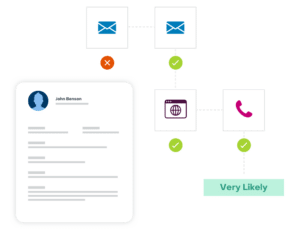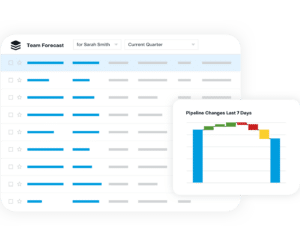Leads vs Opportunities: 6 Ways You Can Manage Sales Pipeline in Your CRM
CRM Basics: Marketing and Sales Concepts
What’s a lead? Simply put, a lead in B2B (business to business) sales and marketing process is a person at a company who has an interest in your products or services. Leads typically are sourced by a marketing department and go through different stages in a qualification lifecycle. These leads are discovered, qualified, and handed over to a salesperson to go through a sales process. The three stages of a lead lifecycle are MQLs (marketing-qualified leads), SRLs (sales-ready leads), and SQLs (sales-qualified leads).
MQLs
A marketing-qualified lead (MQL) is a potential customer that has been reviewed by the marketing team, often via marketing automation software, and satisfies the criteria necessary to be passed along to the sales team. Businesses often have a team of dedicated sales development reps (SDRs) who review MQLs handed over by the marketing team to ensure that the MQL meets the company’s budget, authority, need, and timing (BANT) criteria and is therefore ready to work with a salesperson.
MQLs are managed in the Leads module in SugarCRM. A standard marketing efficiency metric measures the conversion rate of MQLs into SRLs. A well-managed lead qualification process should typically expect about 20-40% of MQLs to convert into SRLs. Since many MQLs typically do not convert into an SRL, it is essential to manage the MQLs (leads) separately from the sales pipeline (opportunities). In short, SDRs work in leads, and salespeople work in opportunities.

SRLs
A sales-ready lead (SRL) is a lead that has been handed to the sales team as an opportunity and is ready for a salesperson to inspect and for immediate follow-up. This is typically the first sales stage of an opportunity’s lifecycle when a salesperson initially engages with the prospect. The salesperson must confirm at this stage that the potential customer still meets budget, authority, need, and timing (BANT) criteria as identified in the marketing qualification process. Sometimes buying initiatives may stall or simply stop early on despite the SRL meeting the initial BANT criteria determined upon first contact as an MQL.
SRLs are managed in the Opportunity module in SugarCRM and are tracked in the first opportunity sales stage as “unqualified sales pipeline.” A well-managed lead qualification process should typically expect about 80-90% of SRLs to convert into SQLs.
SQLs
A sales-qualified lead (SQL) is a lead the salesperson has qualified as a legitimate opportunity to pursue. SQLs are managed in the Opportunity module in SugarCRM and are tracked in the second opportunity sales stage as “qualified sales pipeline.” Once an opportunity has entered the second sales stage as an SQL, the salesperson will initiate a sales discovery process to uncover the prospect’s business problems and map them to the product or service the salesperson is selling. Later sales stages will track the negotiation and contract steps.
Qualifying Pipeline
A company will track its qualified pipeline as opportunities in the second sales stage through the final closed won sales stage. Common sales performance metrics will measure the four “V’s” of the qualified pipeline:
- Volume or how many opportunities are in the pipeline.
- Value or total monetary value of the pipeline.
- Velocity or how quickly opportunities move through each sales stage
- conVersions, or the percentage of leads and opportunities converted into each next stage of the lifecycle.
The most common conversion metrics are MQL conversion rate—as defined above, SRL conversion rate—as defined above, and win rate—the amount of the qualified pipeline that is won. Win rates are typically calculated only against qualified pipelines. A well-managed sales process should expect a 30% win rate for new customers and a 75% win rate for up or cross-selling more products or services to an existing customer. Every company will have slightly different standard conversion metrics based on the nature of their business and the sales teams’ performance.
Pipeline Forecasting
An important metric for measuring the likelihood of qualified pipeline converting into closed-won business is to track the sales forecast. The sales forecast is a process by which a salesperson will predict, or forecast, which opportunities will be won. Sales leaders will then roll up that forecast through each level of sales management to determine a sales team’s total forecast of predicted revenue in each quarter or whatever fiscal period a company manages.
Sales management will typically review the sales pipeline each week to determine which opportunities are in forecast (expected to win) and which are in upside (uncertain at this time whether a win will happen). A sales forecast review will often happen between the sales manager and the individual salespeople at the end of each week. At the beginning of the subsequent week, the sales managers will review their team forecast rollup with upper management and other business stakeholders.

Hunting vs. Farming
A set of common sales concepts are hunting and farming. The main difference in the hunter vs. farmer sales approach is how they generate revenue. The hunter salesperson drives revenue by generating new leads from previously unknown targets and converting them into new customers. On the other hand, the farmer generates revenue by nurturing, closing, and growing existing customers. They cultivate what’s already there.
A hunter sales model will create interest through inbound marketing or outbound marketing and attempt to generate as many new leads as possible from previously unknown targets for the hunters to then pursue. Speed-to-first-engagement with a prospect who expresses interest is the key to success in a hunter methodology. This sales methodology relies upon marketing to create many MQLs for the sales team to further qualify and rely upon the Leads module in CRM.
A farmer sales model will create interest through continuous sales and marketing engagement with a known set of named accounts. Persistent and frequent engagement with the known account defines success in the farmer methodology. This sales methodology relies upon the marketing team to support the sales team in a combined effort to engage continuously with named accounts. It may rely solely on the Opportunity module in CRM to track SRLs through mature deals.
It is common for businesses to apply the hunter sales model to pursue new customers and the farmer sales model to retain and grow existing customers. However, it is important to call out that some businesses operate within a well-defined ecosystem of known potential customers. It will apply the farmer sales model to both signing up new customers and retaining/growing existing customers.
Closing Thoughts
This overview should clarify for you how to use CRM leads and CRM opportunities in your sales and marketing processes. Note that these concepts and accompanying data modeling are not unique to SugarCRM but will be found in every CRM system in the market.
Interested in learning more about lead generation strategy to help your organization create pipeline and increase close rate? Download our guide, “The Lead Generation Strategy Guide.”



